Ablation of BATF Alleviates Transplant Rejection via Abrogating the Effector Differentiation and Memory Responses of CD8+ T Cells
- PMID: 35514970
- PMCID: PMC9062028
- DOI: 10.3389/fimmu.2022.882721
Ablation of BATF Alleviates Transplant Rejection via Abrogating the Effector Differentiation and Memory Responses of CD8+ T Cells
Abstract
Allogeneic CD8+ T cells are prominently involved in allograft rejection, but how their effector differentiation and function are regulated at a transcriptional level is not fully understood. Herein, we identified the basic leucine zipper ATF-like transcription factor (BATF) as a key transcription factor that drives the effector program of allogeneic CD8+ T cells. We found that BATF is highly expressed in graft-infiltrating CD8+ T cells, and its ablation in CD8+ T cells significantly prolonged skin allograft survival in a fully MHC-mismatched transplantation model. To investigate how BATF dictates allogeneic CD8+ T cell response, BATF-/- and wild-type (WT) CD8+ T cells were mixed in a 1:1 ratio and adoptively transferred into B6.Rag1-/- mice 1 day prior to skin transplantation. Compared with WT CD8+ T cells at the peak of rejection response, BATF-/- CD8+ T cells displayed a dysfunctional phenotype, evident by their failure to differentiate into CD127-KLRG1+ terminal effectors, impaired proliferative capacity and production of pro-inflammatory cytokines/cytotoxic molecules, and diminished capacity to infiltrate allografts. In association with the failure of effector differentiation, BATF-/- CD8+ T cells largely retained TCF1 expression and expressed significantly low levels of T-bet, TOX, and Ki67. At the memory phase, BATF-deficient CD8+ T cells displayed impaired effector differentiation upon allogeneic antigen re-stimulation. Therefore, BATF is a critical transcriptional determinant that governs the terminal differentiation and memory responses of allogeneic CD8+ T cells in the transplantation setting. Targeting BATF in CD8+ T cells may be an attractive therapeutic approach to promote transplant acceptance.
Keywords: BATF; CD8+ T cells; allograft rejection; effector differentiation; memory; transplantation.
Copyright © 2022 Li, Zou, Chen, Cheng, Britz, Weng and Liu.
Conflict of interest statement
The authors declare that the research was conducted in the absence of any commercial or financial relationships that could be construed as a potential conflict of interest.
Figures
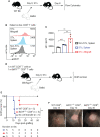

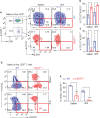
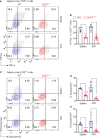
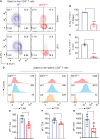
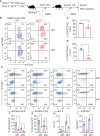
Similar articles
-
BATF and BATF3 deficiency alters CD8+ effector/exhausted T cells balance in skin transplantation.Mol Med. 2024 Jan 31;30(1):16. doi: 10.1186/s10020-024-00792-0. Mol Med. 2024. PMID: 38297190 Free PMC article.
-
Interferon regulatory factor 4 deficiency in CD8+ T cells abrogates terminal effector differentiation and promotes transplant acceptance.Immunology. 2020 Dec;161(4):364-379. doi: 10.1111/imm.13258. Epub 2020 Oct 12. Immunology. 2020. PMID: 32892353 Free PMC article.
-
Genetically targeting the BATF family transcription factors BATF and BATF3 in the mouse abrogates effector T cell activities and enables long-term heart allograft survival.Am J Transplant. 2022 Feb;22(2):414-426. doi: 10.1111/ajt.16861. Epub 2021 Oct 15. Am J Transplant. 2022. PMID: 34599765 Free PMC article.
-
The transcription factor BATF modulates cytokine-mediated responses in T cells.Cytokine Growth Factor Rev. 2016 Aug;30:39-45. doi: 10.1016/j.cytogfr.2016.03.004. Epub 2016 Mar 6. Cytokine Growth Factor Rev. 2016. PMID: 26970726 Review.
-
BATF-mediated regulation of exhausted CD8+ T-cell responses and potential implications for chimeric antigen receptor-T therapy.Immunotherapy. 2024 Mar;16(5):331-340. doi: 10.2217/imt-2023-0170. Epub 2024 Jan 24. Immunotherapy. 2024. PMID: 38264838 Review.
Cited by
-
BATF and BATF3 deficiency alters CD8+ effector/exhausted T cells balance in skin transplantation.Mol Med. 2024 Jan 31;30(1):16. doi: 10.1186/s10020-024-00792-0. Mol Med. 2024. PMID: 38297190 Free PMC article.
-
The role of BATF in immune cell differentiation and autoimmune diseases.Biomark Res. 2025 Jan 29;13(1):22. doi: 10.1186/s40364-025-00733-x. Biomark Res. 2025. PMID: 39876010 Free PMC article. Review.
-
An Immune Atlas of T Cells in Transplant Rejection: Pathways and Therapeutic Opportunities.Transplantation. 2023 Nov 1;107(11):2341-2352. doi: 10.1097/TP.0000000000004572. Epub 2023 Oct 21. Transplantation. 2023. PMID: 37026708 Free PMC article.
References
Publication types
MeSH terms
Substances
Grants and funding
LinkOut - more resources
Full Text Sources
Research Materials

